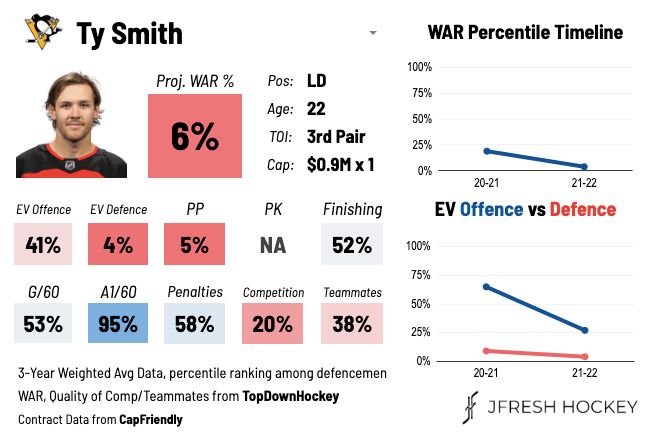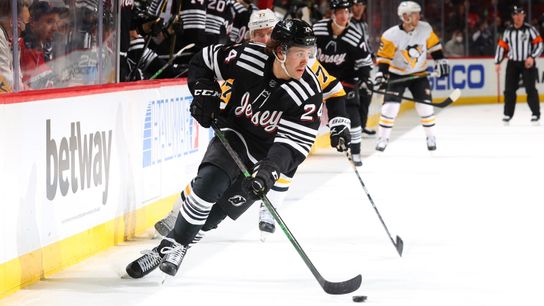Among the Penguins' long list of defensemen is newly acquired Ty Smith, who was included along with a 2023 third-round draft pick in the return for John Marino.
Smith had an eye-catching rookie season in 2020-21, producing two goals and 21 assists in only 41 games with the Devils. While points aren't everything -- especially for defensemen -- it had to mean something for a former first-rounder to burst on the scene like that at the age of 20 ... right?
Last season Smith saw his total production drop by three points (five goals, 15 assists) despite playing in 18 more games. Still respectable, all things considered, it wasn't the followup season the Devils had hoped for. They ultimately decided he was worth moving on from in favor of Marino.
A quick glimpse under the hood, perhaps, gives some insight as to why.
During the 1,815 minutes that Smith spent on the ice at 5-on-5 during his first two seasons, the Devils were outscored 96-69 (41.8%) and generated a slightly better but still lousy 47.6% of the expected goals, according to Evolving-Hockey.
Smith's on-ice metrics actually dropped in his second season, just like his production. The Devils buried just 39.8% of the goals when he was out there at 5-on-5, and although some of that is due to poor goaltending (.892 on-ice save percentage), their 47% expected goals share was proof enough they were getting handily outplayed.
The Devils have been bottom-feeders each of the past two seasons, but poor results like that aren't entirely absolved due to playing with unspectacular teammates, especially considering his quality of competition typically consisted of the lower-level variety.
Nevertheless, Ron Hextall and co. aren't worried.
"Certainly nothing we’ve uncovered that’s cause for concern," Hextall responded when asked about Smith’s disappointing sophomore season immediately following the trade. "The upside is pretty high."
What's concerning, at least to me, is that on top of his poor on-ice results, his isolated impact on his team's ability to limit quality chances against grades out worse than nearly every other blue liner in the NHL during his two seasons. And while his isolated impact on offense was well above average in his rookie season, it plummeted to right around replacement-level last season, visualized by JFreshHockey. (You can read an explainer on the values here.)

JFreshHockey
That's just one isolated impact model, but Evolving-Hockey's model rated Smith as the sixth-worst play-driving defender in the NHL last season, and HockeyViz's model believes his overall impact on chances for and against is 18% worse than an average defender.
Smith is only 22, so the verdict isn't out on him by any means, but it appears even his strong primary assist rate might currently be buoyed from some luck.
A chunk of his 14 primary assists during his rookie season came on deflections or rebounds from point shots. Last season, all five of his primary assists were his own long-distance shots that got tipped on their way in. It is a skill to find lanes and sticks through traffic from distance, but it should be viewed more as a last resort play as opposed to working pucks to the middle of the ice and across the slot for much higher quality looks.
That said, I could see him finding the back of the net once or twice a season with a move like this, in which he attacks downhill rather than drifting to the outside as he fires:
Not quite the same finesse as Auston Matthews, but not every defenseman can stop on a dime like that and fire a curl and drag, either.
According to the manual tracking of Corey Sznajder from AllThreeZones, Smith ranked in the 86th percentile among league defensemen in rush assists last season and in the 54th percentile of in-zone assists, so there does seem to be some playmaking in there even if he has benefitted from a bit of an inflated assist rate to this point.
Smith is at his best when he's got speed and momentum. He's not afraid to skate the puck and tends do so if he has the time and space. He doesn't really try and dangle his way through multiple defenders, but instead draws them in by taking the middle of the ice and slipping passes to his flanks:
On another end-to-end rush just several minutes later in the same game, Smith gets a full head of steam up ice but isn't able to penetrate the center lane to gain the offensive zone, and is forced to the outside. Unlike the guy he was traded for, Smith didn't skate himself into a compromised position in the corner, and instead opened up toward the middle of the ice to scan the ice for pass options. The center lane isn't going to be an option to enter the zone all that regularly, so making the most out of very little -- even if it's just extending possession or not turning the puck over -- becomes pretty important.
After a lot of off-puck movement and rotating, Smith received a pass from Jack Hughes while going against the grain, attacked downhill, sold a shot or pass to freeze his checker, then dangled to the backhand and flung a puck out front that ended up in the back of the net:
As harsh as I've been on Smith to this point, it's not all that hard to see some of the upside Hextall referred to.
In addition to his dishing ability on the rush, he's also shown to be a threat by rushing into wide-open ice as a trailer and catching the defense off guard, or weaving in and out lanes behind the puck carrier to keep coverage guessing:
Smith started that rush as the very last player back and still managed to get on his horse and participate in the rush. He did a great job of reading off of his teammates and anticipating their next moves, as he smartly overlapped with Jesper Bratt, streaking right into a soft pocket of open ice right in the slot.
Bratt hit him with a feed in the wheelhouse and Smith made no mistake. He scored several other times in near identical fashion last season.
Unfortunately, outside of when he's not building speed and momentum on his way into the offensive zone, his defensive shortcomings cause his team to spend extended time in their own end before the puck inevitably ends up in the back of the net.
Smith is 5-foot-11 and only 180 pounds, and opposing forwards just have their way with him in the corners, along the wall and at the net-front. He struggles mightily to do any sort of crease-clearing and loses the vast majority of puck battles along the wall unless he swats the puck away from everyone in the immediate vicinity.
That means less possession, more defensive-zone work and an increasing number of shots and goals against.
More defensive-zone work is a problem because Smith hasn't shown capable of being able to use his noggin, feet or stick to make up for his lack of size:
For a smaller guy, Smith doesn't have a great first step. He doesn't have a whole lot of acceleration off the jump. That was the first domino of many that fell in the sequence above.
After getting boxed out in a race for the puck behind his own net, Smith locked his eyes on the puck in the corner for several seconds. He did not shoulder check or take a look around once, and if he had, it probably would've been the extra split second he needed to get some wood on the pass to the slot. Now, I wouldn't expect him to shade up and away from the post to mark the shooter because that's not his assignment, but he has to be more aware of his surroundings.
Then, just seconds later, with his defense partner already engaged and occupied way out of the play, Smith inexplicably chased after the carrier in the corner, completely vacating the net-front area. He was lucky the sequence didn't end with the puck in his net.
Smith is also guilty of trying to overthink it sometimes. His decision-making needs to improve under pressure:
A lack of a decent burst for his size is part of the reason he ends up getting swarmed and turning the puck over. On occasion he doesn't have the quickness or foot speed to create meaningful separation under pressure, which causes him to force dangerous passes through sticks and bodies so he can get rid of it.
This, too, is another reason why the Devils spent a fair chunk of his time chasing the puck around in their zone, and why his defensive impacts have graded out so poorly.
Typically I don't like to show so many clips from the same game in this type of breakdown, but this final clip really makes me wonder how much working with Todd Reirden might benefit Smith:
What possessed him to attempt that pass and why was any sort of decision not made much sooner? Or why didn't he move his feet and skate the puck? I won't speak to the Devils' coaching, but plays like that lead me to believe he's been misguided to an extent.
Reirden isn't infallible. He can't completely change a player. He can't make a player become one they aren't. But, he has shown a tendency to squeeze the most out of defensemen who have struggled previously, like Cody Ceci and Mike Matheson.
As of right this second, I wouldn't be comfortable asserting that Smith is a better overall player than P.O Joseph. I believe Smith's offensive ceiling to be higher, but for him to truly unlock that ceiling he will have to make major strides on several key areas in his own zone.

